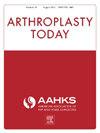Outcomes After Patellofemoral Arthroplasty With the Arthrex iBalance—A Third Generation Implant
IF 1.5
Q3 ORTHOPEDICS
引用次数: 0
Abstract
Background
Patellofemoral arthroplasty (PFA) is an attractive option for patients who have isolated patellofemoral disease. This study aimed to assess the functional outcomes and revision rates of primary PFA with a third-generation implant with short- to medium-term follow-up.
Methods
We retrospectively reviewed the records of 49 patients (70 knees) undergoing PFA with the iBalance system by a single surgeon at a quaternary center between January 2015 and September 2022 for demographic and surgical data, as well as complications and revision rates. Patient-reported outcome scores were then collected.
Results
The population was majority female (81.6%) with a median age of 50 years. Four knees were revised to a total knee arthroplasty (5.7%) at an average time point of 2.3 years postoperatively (range: 1.3-3.5 years). The median Single Assessment Numeric Evaluation score at the time of follow-up was 82.5, while the median Kujala score was 72. Lower preoperative Kellgren-Lawrence grade was significantly associated with lower Knee Injury and Osteoarthritis Outcome Scores in all 5 domains (P < .05 for all). Additional procedures were required in 17 knees (24.3%), in most cases to improve patella tracking.
Conclusions
This study is, to our knowledge, the first to examine outcomes of the iBalance PFA system. The results show favorable patient-reported outcomes in this cohort consistent with other 2nd and 3rd generation PFA implants, along with a revision rate similar to its prosthetic peers.
求助全文
约1分钟内获得全文
求助全文
来源期刊

Arthroplasty Today
Medicine-Surgery
CiteScore
2.90
自引率
0.00%
发文量
258
审稿时长
40 weeks
期刊介绍:
Arthroplasty Today is a companion journal to the Journal of Arthroplasty. The journal Arthroplasty Today brings together the clinical and scientific foundations for joint replacement of the hip and knee in an open-access, online format. Arthroplasty Today solicits manuscripts of the highest quality from all areas of scientific endeavor that relate to joint replacement or the treatment of its complications, including those dealing with patient outcomes, economic and policy issues, prosthetic design, biomechanics, biomaterials, and biologic response to arthroplasty. The journal focuses on case reports. It is the purpose of Arthroplasty Today to present material to practicing orthopaedic surgeons that will keep them abreast of developments in the field, prove useful in the care of patients, and aid in understanding the scientific foundation of this subspecialty area of joint replacement. The international members of the Editorial Board provide a worldwide perspective for the journal''s area of interest. Their participation ensures that each issue of Arthroplasty Today provides the reader with timely, peer-reviewed articles of the highest quality.
 求助内容:
求助内容: 应助结果提醒方式:
应助结果提醒方式:


